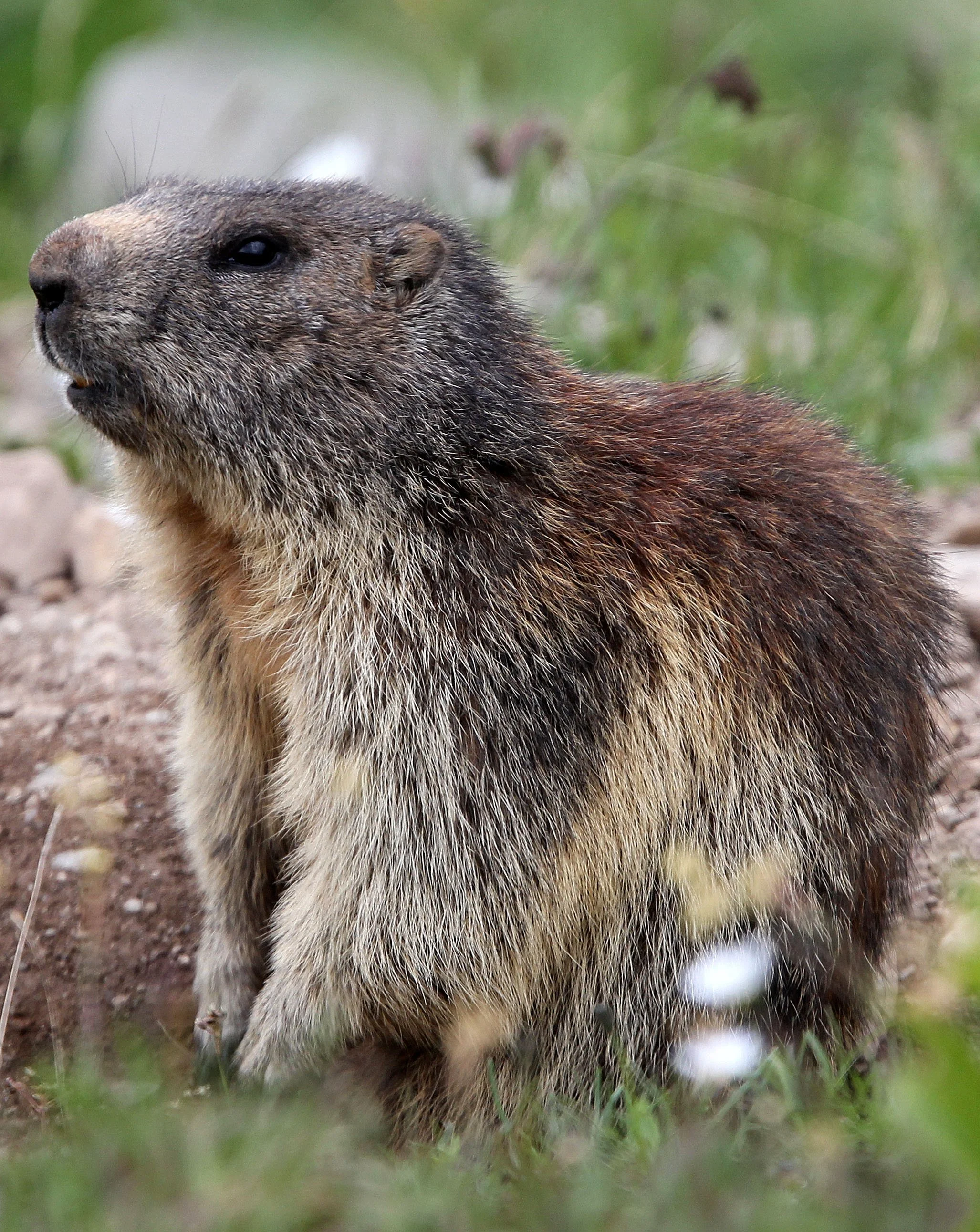

Marmots are large ground squirrels in the genus Marmota, with 15 species living in Asia, Europe, and North America. These herbivores are active during the summer, when they can often be found in groups, but are not seen during the winter, when they hibernate underground. They are the heaviest members of the squirrel family. In this gallery, I will showcase the various species of Marmots I have seen in North America, Europe and Asia over the years.
The following species have images galleries:
Yellow-bellied Marmot (Marmota flaviventris)
Groundhog (Marmota monax)
Hoary Marmot (Marmota caligata)
Olympic Marmot (Marmota olympus)
Vancouver Island Marmot (Marmota vancouverensis)
Gray or Altay Marmot (Marmota baibacina)
Himalayan marmot (Marmota himalayana)
Alpine Marmot (Marmota marmota)
The Yellow-bellied Marmot (Marmota flaviventris), also known as the rock chuck, is a large, stout-bodied ground squirrel in the marmot genus. It is one of fourteen species of marmots, and is native to mountainous regions of southwestern Canada and western United States, including the Rocky Mountains, Sierra Nevada, and Mount Rainier in the state of Washington, typically living above 2,000 metres (6,500 feet)[citation needed]. The fur is mainly brown, with a dark bushy tail, yellow chest and white patch between the eyes, and they weigh up to approximately 5 kilograms (11 pounds). They live in burrows in colonies of up to twenty individuals with a single dominant male. They are diurnal and feed on plant material, insects, and bird eggs. They hibernate for approximately eight months starting in September and lasting through the winter.
The yellow-bellied marmot lives in southwestern Canada and western United States, including the Rocky Mountains and the Sierra Nevada.[5] Northwards, its range extends into the southern British Columbia and goes eastwards up to the montane and basin regions of Wyoming, eastern Montana, Colorado, and southern Alberta. Southwards, its range extends into northern New Mexico. It inhabits steppes, meadows, talus fields, and other open habitats, sometimes on the edge of deciduous or coniferous forests. In Colorado, they are found from as low as 1,600 m (5,400 ft) to over 4,300 m (14,000 ft) of elevation. In central and eastern Washington, they are common at low elevations.
They are found in valleys, meadows, and foothills, and tend to occupy open areas which are free of vegetation. Their territory is about 2.5 hectares (6 acres) around a number of burrows dug during the summer. They choose to dig burrows under rocks, as it is less likely to be visible to predators. These predators include foxes, dogs, coyotes, wolves, and eagles. Upon seeing a predator, the yellow-bellied marmot whistles to warn the others in the area, after which it typically hides in a nearby rock pile until there is no more threat.
The below galleries have image of various subspecies of Yellow-bellied Marmots followed by other Marmota species.
Rocky Mountains Yellow-bellied Marmot (Marmota flaviventris luteola) - Mount Evans Recreation Area, Rocky Mountains National Park



































































Yellow-bellied Marmot (Marmota flaviventris avara) - Eastern Washington, Idaho








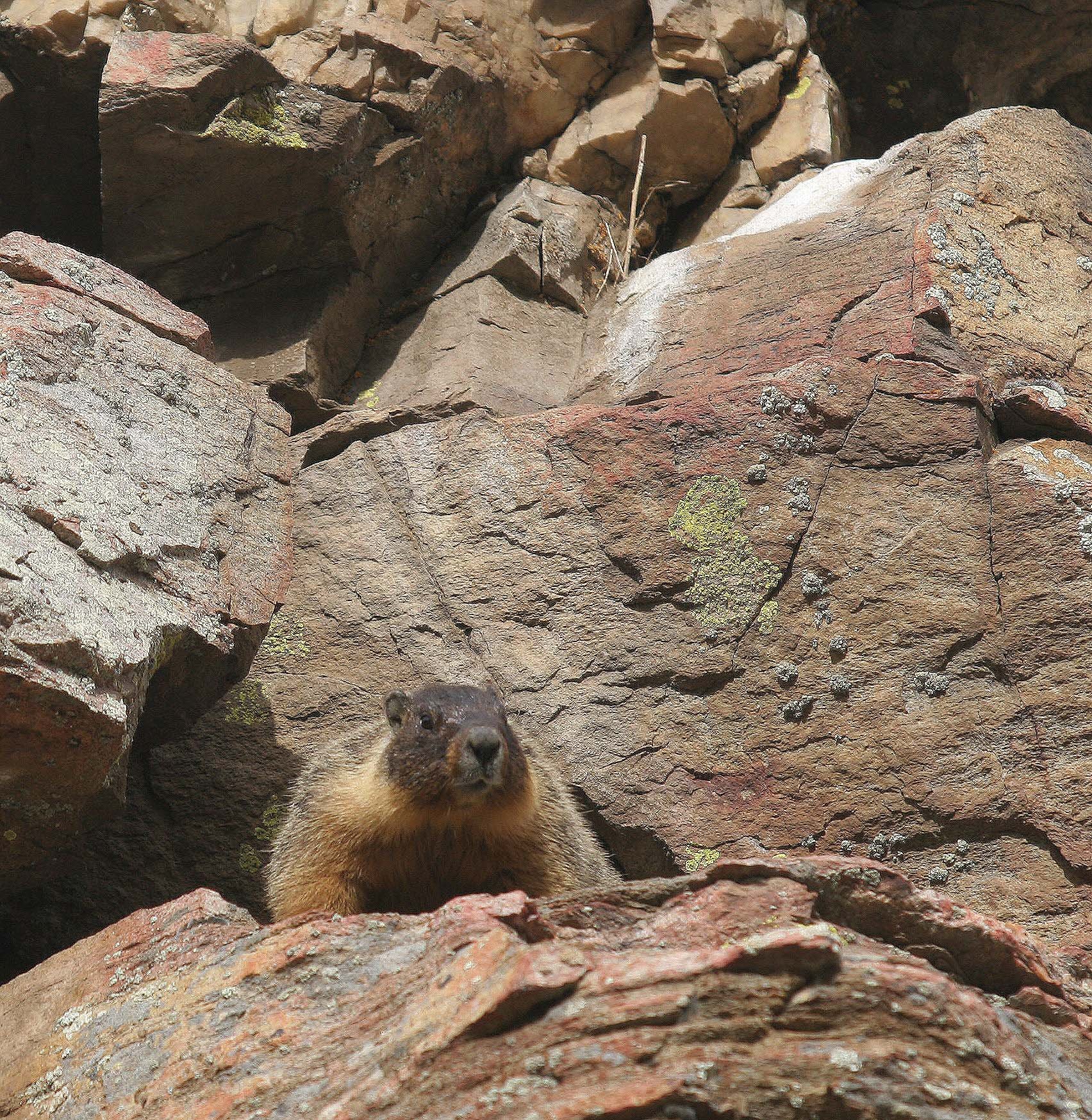
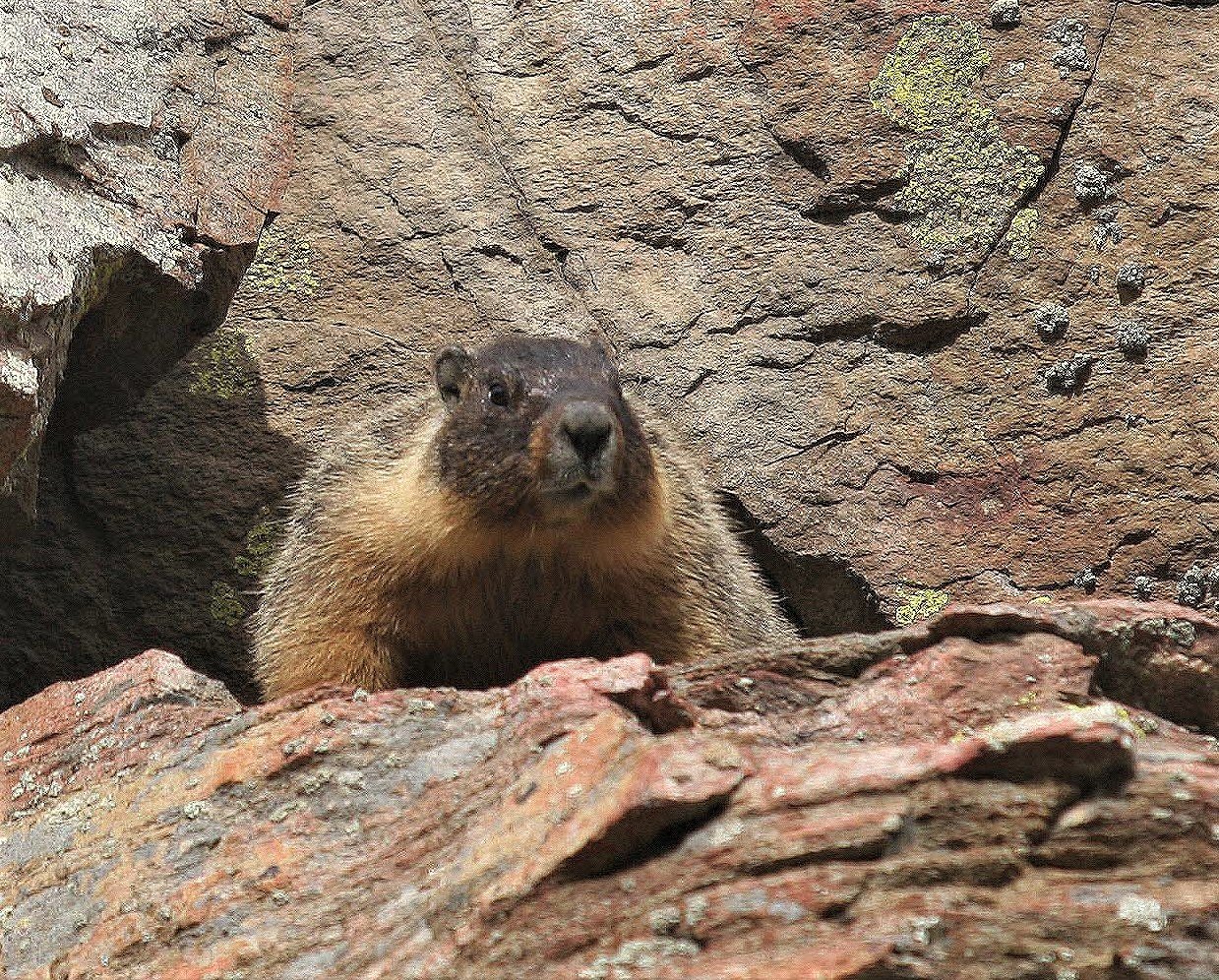
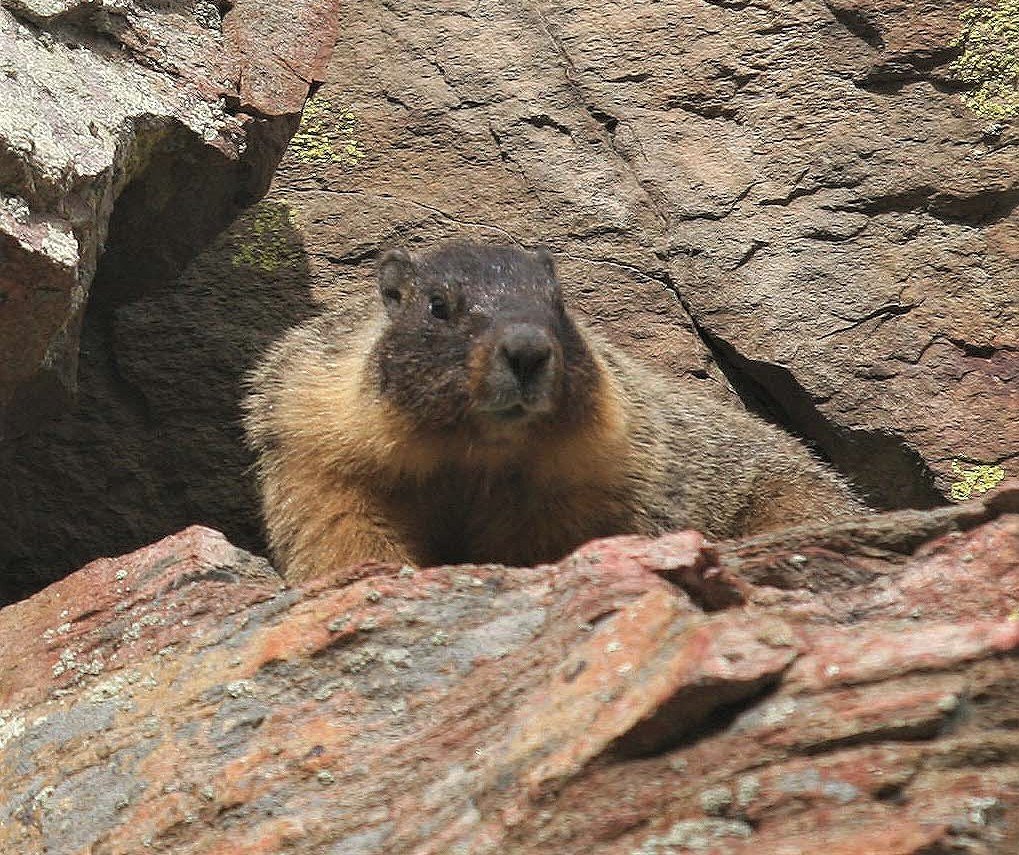
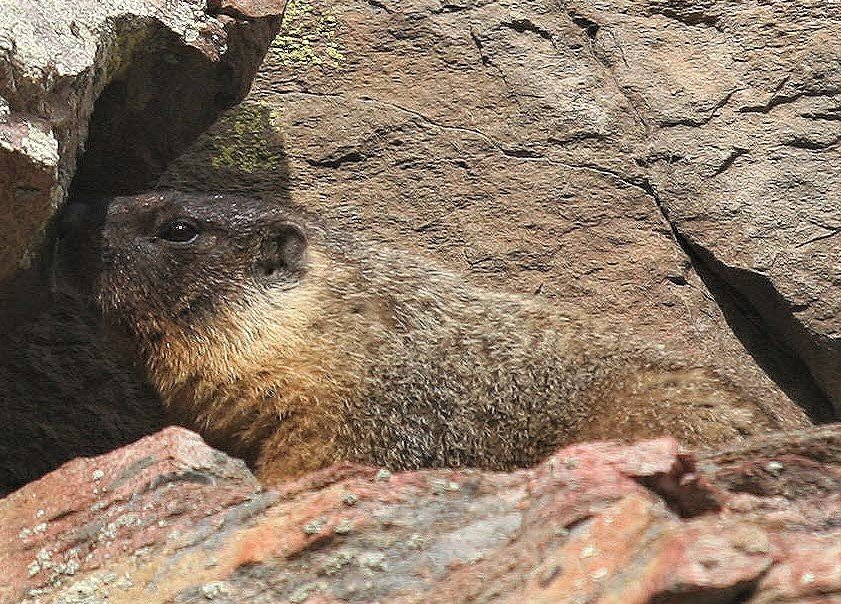
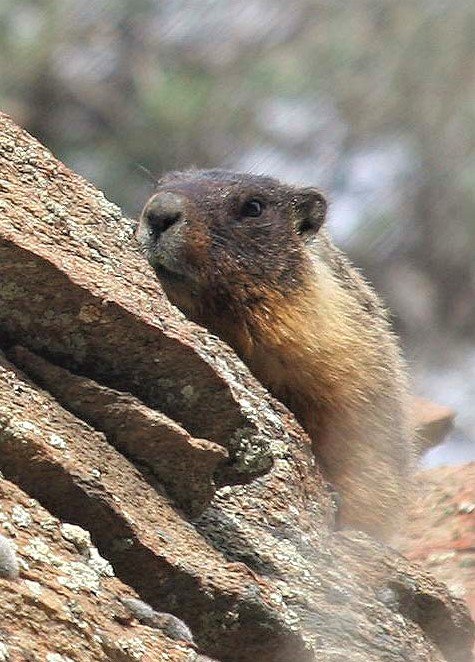

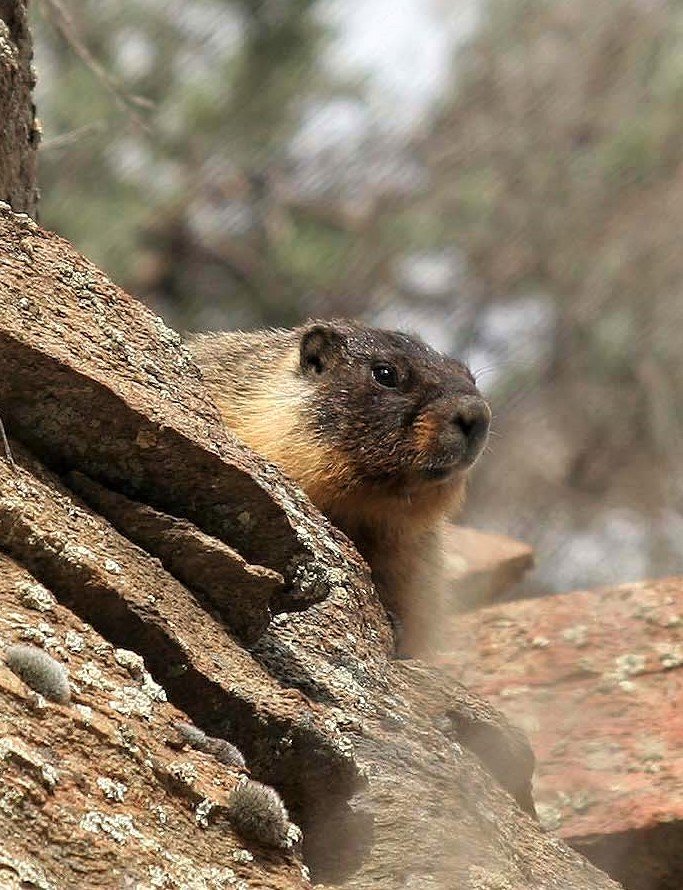
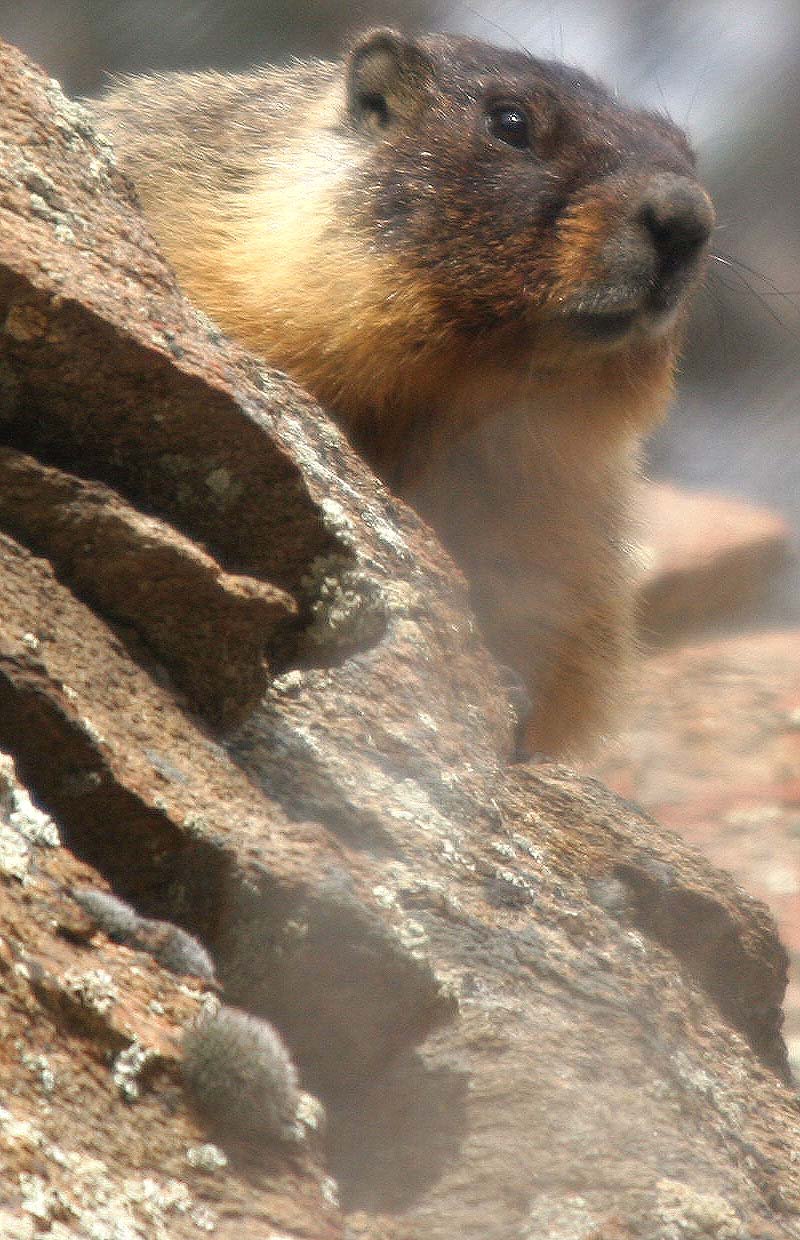
The Groundhog (Marmota monax), also known as a woodchuck, is a rodent of the family Sciuridae, belonging to the group of large ground squirrels known as marmots. The groundhog is a lowland creature of North America; it is found through much of the Eastern United States, across Canada and into Alaska. It was first scientifically described by Carl Linnaeus in 1758.
The groundhog is also referred to as a chuck, wood-shock, groundpig, whistlepig, whistler, thickwood badger, Canada marmot, monax, moonack, weenusk, red monk, land beaver, and, among French Canadians in eastern Canada, siffleux. The name "thickwood badger" was given in the Northwest to distinguish the animal from the prairie badger. Monax (Móonack) is an Algonquian name of the woodchuck, which means "digger" (cf. Lenape monachgeu). Young groundhogs may be called chucklings.
The groundhog, being a lowland animal, is exceptional among marmots. Other marmots, such as the yellow-bellied and hoary marmots, live in rocky and mountainous areas. Groundhogs play an important role maintaining healthy soil in woodlands and plains. The groundhog is considered a crucial habitat engineer. Groundhogs are considered the most solitary of the marmot species. They live in aggregations, and their social organization also varies across populations. Groundhogs do not form stable, long-term pair-bonds, and during mating season male-female interactions are limited to copulation. In Ohio, adult males and females associate with each other throughout the year and often from year to year. Groundhogs are an extremely intelligent animal forming complex social networks, able to understand social behavior, form kinship with their young, understand and communicate threats through whistling, and work cooperatively to solve tasks such as burrowing.
The groundhog prefers open country and the edges of woodland, and is rarely far from a burrow entrance. Marmota monax has a wide geographic range. It is typically found in low-elevation forests, small woodlots, fields, pastures, and hedgerows. It constructs dens in well-drained soil, and most have summer and winter dens. Human activity has increased food access and abundance, allowing M. monax to thrive.
Woodchuck or Ground Hog (Marmota monax) - Suburban Chicago, Illinois












The Hoary Marmot (Marmota caligata) is a species of marmot that inhabits the mountains of northwest North America. Hoary marmots live near the tree line on slopes with grasses and forbs to eat and rocky areas for cover.
It is the largest North American ground squirrel and is often nicknamed "the whistler" for its high-pitched warning issued to alert other members of the colony to possible danger. The animals are sometimes called "whistle pigs". Whistler, British Columbia, originally London Mountain because of its heavy fogs and rain, was renamed after these animals to help make it more marketable as a resort. The closest relatives of the species are the yellow-bellied, Olympic, and Vancouver Island marmots, although the exact relationships are unclear.
The hoary marmot predominantly inhabits mountainous alpine environments to 2,500 metres (8,200 ft) elevation, although coastal population also occur at or near sea level in British Columbia and Alaska. Hoary marmots occur from southern Washington and central Idaho north, and are found through much of Alaska south of the Yukon River. They live above the tree line, at elevations from sea level to 2,500 metres (8,200 ft), depending on latitude, in rocky terrain or alpine meadows dominated by grasses, sedges, herbs, and Krummholz forest patches. Range maps often erroneously depict hoary marmots occurring north of the Yukon River in Alaska, this region is occupied by the Alaska marmot (M. broweri) and not the hoary marmot. Hoary marmots also occur on several islands in Alaska and fossils dating back to the Pleistocene, including some from islands no longer inhabited by the species.
The three currently recognized subspecies are:
Marmota caligata caligata – Alaska, Yukon, NW Territories, northern British Columbia
Marmota caligata cascandensis – Cascade Mountains, from British Columbia to Washington
Marmota caligata okanagana – Rocky Mountains, from Yukon to Montana and Idaho (See the below Gallery)
Hoary Marmot (Marmota caligata okanagana) - Glacier National Park, Montana




The Olympic Marmot (Marmota olympus) is a rodent in the squirrel family, Sciuridae; it occurs only in the U.S. state of Washington, on the middle elevations of the Olympic Peninsula. The closest relatives of this species are the hoary marmot and the Vancouver Island marmot. In 2009, it was declared the official endemic mammal of Washington.
This marmot is about the size of a domestic cat, typically weighing about 8 kg (18 lb) in summer. The species shows the greatest sexual dimorphism found in marmots, with adult males weighing on average 23% more than females. It can be identified by a wide head, small eyes and ears, stubby legs, and a long, bushy tail. Its sharp, rounded claws aid in digging burrows. The coat color changes with the season and with age, but an adult marmot's coat is brown all over with small whiter areas for most of the year.
The species has a diet consisting mainly of a variety of meadow flora, including dry grasses, which it also uses as bedding in burrows. It is preyed on by various terrestrial mammals and avian raptors, but its main predator today is the coyote, however the complex system of communication through whistling means most marmots remain safe for their entire life. The Olympic marmot is rated a species of the least concern on the IUCN Red List. It is protected by law in the Olympic National Park, which contains most of its habitat.
The burrows of this marmot are made in colonies, which are found in various mountain locations and differ in size. A colony may contain as few as one marmot family or multiple families with up to 40 marmots. Olympic marmots are very sociable animals which often engage in play fighting and vocalize four different whistles to communicate. During hibernation beginning in September, they are in a deep sleep and do not eat, causing them to lose half their body mass. Adults emerge in May and their young in June. Female marmots reach sexual maturity at three years of age, and produce litters of 1–6 every other mating season.
Olympic Marmot near Hurricane Ridge, Olympic National Park, Washington
Olympic marmots are native to the Olympic Mountains in the Olympic Peninsula of Washington state. About 90% of Olympic marmots' total habitat is located in Olympic National Park, where they are often sighted, especially on Hurricane Hill. Marmots are in decline in some areas of the park due to the encroachment of trees into meadows as well as predation by coyotes, and they are seldom seen in the wetter southwestern part.
Within the park, Olympic marmots inhabit lush sub-alpine and alpine meadows, fields, and montane scree slopes. They live in colonies spread out in various locations in the mountains and containing the burrows of differing numbers of marmot families. Some meadows can contain as few as one marmot family, and some can have multiple families adding up to 40 marmots. There is a higher risk of inbreeding and death from random events in meadows with fewer marmots, making migration essential to the survival of the species. Burrows can be found at elevations ranging from 920 m (3,020 ft) to 1,990 m (6,530 ft); they are most often found in the range of 1,500 m (4,900 ft) to 1,750 m (5,740 ft). Burrows are more frequently located on south-facing slopes, which generally receive more precipitation, 75 cm (30 in) per year (mostly snow), and thus have more available flora. The home range of a family of marmots usually covers from half an acre to five acres (0.2–2 hectares). The Olympic marmot is well-adapted to its generally cold natural habitat, where there is snowfall almost every month of the year on the mountain slopes and barren grasslands.
Olympic Marmot (Marmota olympus) - Olympic Peninsula and National Park, Washington














































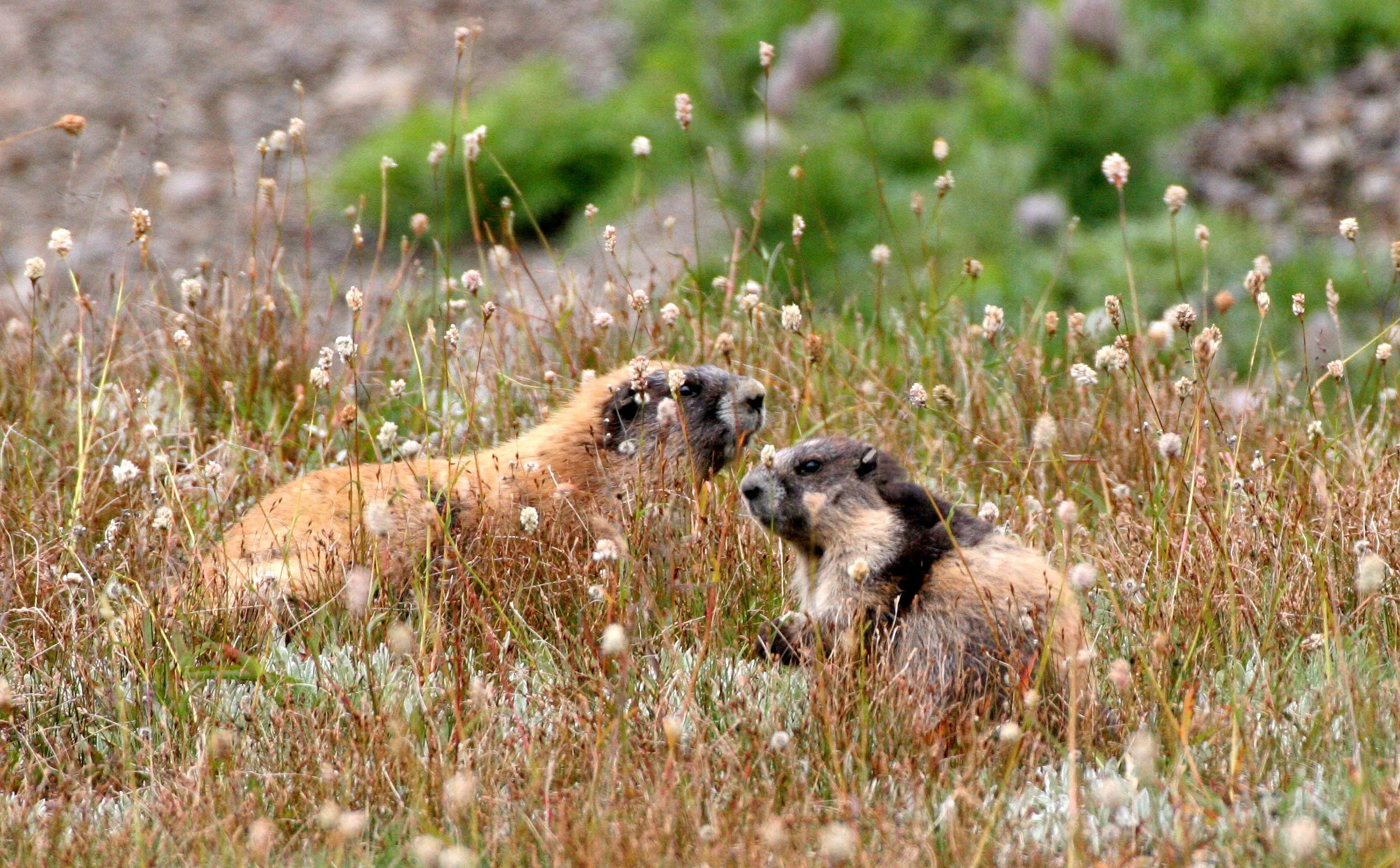











The Vancouver Island Marmot (Marmota vancouverensis) naturally occurs only in the high mountains of Vancouver Island, in British Columbia. This particular marmot species is large compared to some other marmots, and most other rodents. Marmots as a group are the largest members of the squirrel family, with weights of adults varying from 3 to 7 kg depending on age and time of year.
Although endemic to Vancouver Island, Marmota vancouverensis now also resides successfully at several captive breeding centres across Canada as well as several sites on Vancouver Island at which local extinction was observed during the 1990s. This is the result of an ongoing recovery program designed to prevent extinction and restore self-sustaining wild populations of this unique Canadian species. Due to the efforts of the recovery program, the marmot count in the wild increased from fewer than 30 wild marmots in 2003, to an estimated 250–300 in 2015.
Causes of marmot population declines are numerous. Over the long term (i.e., periods involving thousands of years), climate changes have caused both increases and declines of open alpine habitat that constitute suitable marmot habitat.[23] Over more recent time scales, population dynamics may have been influenced by short-term weather patterns and systematic changes in the landscape. In particular, forest clearcutting at low elevations likely altered dispersal patterns. Sub-adult marmots typically disperse from the subalpine meadows in which they were born. Dispersal involves traversing lowland conifer forests and valleys to other subalpine meadows. However, clearcutting has provided marmots with new open areas which constitute habitat. Unfortunately, rapid forest regeneration makes such man-made habitats unsuitable over a few years. One study concluded that clearcuts therefore act as a kind of population "sink" in which long-term reproduction and survival rates are reduced to the point of unsustainability One 2005 study concluded the main cause of recent decline to be predation "associated with forestry and altered predator abundance and hunting patterns". This study also revealed seasonal variations in mortality rates, where the probability of death was low during hibernation, and high in August. Major predators upon Vancouver Island marmots include golden eagles (Aquila chrysaetos), cougars (Puma concolor) and wolves (Canis lupus).
The population crash may also be due to the Allee effect, named after zoologist Warder Clyde Allee. Allee proposed that social animals require a critical mass in order to survive, because survival requires group activities such as warning of predators and migration. A decline below that threshold precipates rapid decline. Ecologist Justin Brashares suggests that at least some of the marmot's group behavior is learned, so that the loss of marmot "culture" has caused them to become more solitary, and interact aggressively rather than cooperatively when they do encounter each other.
Vancouver Marmot on Vancouver Island, BC
The endangered Vancouver Island marmot remains one of the world's rarest mammals. In 1997 there were so few numbers of marmots on Vancouver Island that managers took the bold step of capturing some to create a "genetic lifeboat" and therefore create the possibility of restoring wild populations. The first marmots went to Toronto Zoo in 1997, but this initial effort was quickly followed by efforts made by the Calgary Zoo and Mountainview Conservation and Breeding Centre in Langley, BC. The Marmot Recovery Foundation also built a dedicated marmot facility on Mt. Washington, Vancouver Island to further facilitate captive breeding and pre release conditioning. The fundamental idea was to produce marmots in a fashion that would facilitate their eventual return to the wild.
In 1998 a new model for species recovery was born involving the government, private industry and public donors. A census in late 2003 resulted in a count of only 21 wild marmots known to be present on Vancouver Island. After these findings, marmots were released from captivity in different places to try to get the population back up to a reasonable number.
These marmots are still classified as endangered. The cumulative captive breeding program has steadily grown, with 130 individuals in captivity (2010) and 442 weaned pups born in captivity since 2000. A number of individuals have been released to Strathcona Provincial Park, Mount Cain, Mount Washington and more southern mountains. From 2003–2010 the Marmot Recovery Foundation and the British Columbia Ministry of Environment have released 308 marmots back into the wild. More releases are expected in the upcoming years to increase the wild population, estimated at 250–300 individuals in 2010, and 350–400 individuals in 2013. The wild population was counted at 250 in 2021. Due to conservation and recovery efforts, the population of Vancouver Island Marmots has increased drastically since 2003 to present day. Nevertheles
Vancouver Island Marmot (Marmota vancouveri) - Mount Washington Ski Resort, Vancouver Island British Columbia
























































































































Altai Marmot in Tian Shian Mountains, Xinjiang China
The gray marmot, grey marmot, or Altai marmot (Marmota baibacina) is a species of rodent in the squirrel family Sciuridae. It is one of the larger marmots in the genus Marmota. It occurs in mountainous grasslands and shrub lands of central Asia, and is one of the 9 Palearctic (Eurasia) species. It is found in Xinjiang Province in China, southeastern Kazakhstan, Kyrgyzstan, Mongolia, and in the Altai and Tien Shan Mountains in southeastern Siberia in Russia. In the Mongolian Altai, its range overlaps with that of the Tarbagan marmot. Gray marmots form social groups, live in burrows, and hibernate.
Gray marmots live in mountain meadows and steppes, where they forage on sage bush in the spring, grasses and flowering plants in summer and fall. They occur in elevations from 150 to 4,000 m (490 to 13,120 feet), but may prefer mild to moderate well draining slopes with suitable soil for burrowing. The soil ranges from fine grained soft soil to soil including sand or pebbles. Their distribution extends from the Altai mountains of southwestern Siberia (Tuva, Russia), western Mongolia, northwestern China (Xinjiang), and eastern Kazakhstan, into the Tien Shan mountains of northwestern China, Kyrgyzstan, and southeastern Kazakhstan. In southeastern Kazakhstan and southwestern Siberia the range enters lower elevation, dry steppes. The gray marmot is an introduced species in the Caucasus mountains of Dagestan, Russia. In the Altai mountains of western Mongolia, the range overlaps with the Tarbagan marmot (Marmota sibirica). In this area of range overlap, competition restricts the gray marmot habitat to elevations above 3,000 m (9,800 feet) in areas with scattered boulders and rocks. Observation of hybridization between the two species and living in the same area are rare.
Gray or Altay Marmot (Marmota baibacina) - Tianshian Mountains, Xiangjiang Province China near Kazakhstan Border














































Himalayan Marmot in Ke Ke Xi Li, Qinghai China
The Himalayan marmot (Marmota himalayana) is a marmot species that inhabits alpine grasslands throughout the Himalayas and on the Tibetan Plateau. It is IUCN Red Listed as Least Concern because of its wide range and possibly large population.
Arctomys Himalayanus was the scientific name proposed by Brian Houghton Hodgson in 1841 who described marmot skins from the Himalayas. In the 19th century, several Himalayan marmot specimens were described and proposed as subspecies.
The Himalayan marmot is very closely related to the Tarbagan marmot (M. sibirica) and somewhat more distantly to the—in morphology rather different—black-capped marmot (M. camtschatica). These three form a species group and its nearest relative is the bobak species group, which includes the bobak marmot (M. bobak) itself, as well as the gray (M. baibacina) and forest-steppe marmots (M. kastschenkoi). In the past, the relatively short-furred and short-tailed marmots of the Palearctic region, i.e. Himalayan, Tarbagan, gray and forest-steppe, all were regarded as subspecies of the bobak marmot.
The Himalayan marmot occurs in the Himalayas and Tibetan Plateau at altitudes of 3,000 to 5,500 m (9,800–18,000 ft) in northeastern Pakistan, northern India, Nepal, Bhutan and China. In China, it has been recorded in Xinjiang, Qinghai, Gansu, Xizang, western Sichuan and Yunnan provinces. In the west its distribution reaches that of the long-tailed marmot (M. caudata), but the two are not known to hybridize. The Himalayan marmot lives in short grass steppes or alpine habitats, typically above the tree line but below the permanent snow limit.
The Himalayan marmot lives in colonies and excavates deep burrows that colony members share during hibernation. The species hibernates from the late autumn to the early spring, on average for 71⁄2 months. Burrows are between 2 and 10 m (6.6–32.8 ft) deep, given that the upper soil layer is sufficiently light and deep such as fluvioglacial, deluvial and alluvial deposits. Where soil conditions are ideal on alluvial terraces, marmot colonies comprise up to 30 families, with up to 10 families living in an area of 1 km (0.6 mi). The marmot eats plants growing on pastures, in particular the soft and juicy parts of grassy plant species like Carex, Agrostis, Deschampsia, Koeleria and flowering species like Euphrasia, Gentiana, Halenia, Polygonum, Primula, Ranunculus, Saussurea, Taraxacum Iris potaninii.
Himalayan Marmot (Marmota himalayana) - Various locations in Qinghai on the Tibetan Plateau






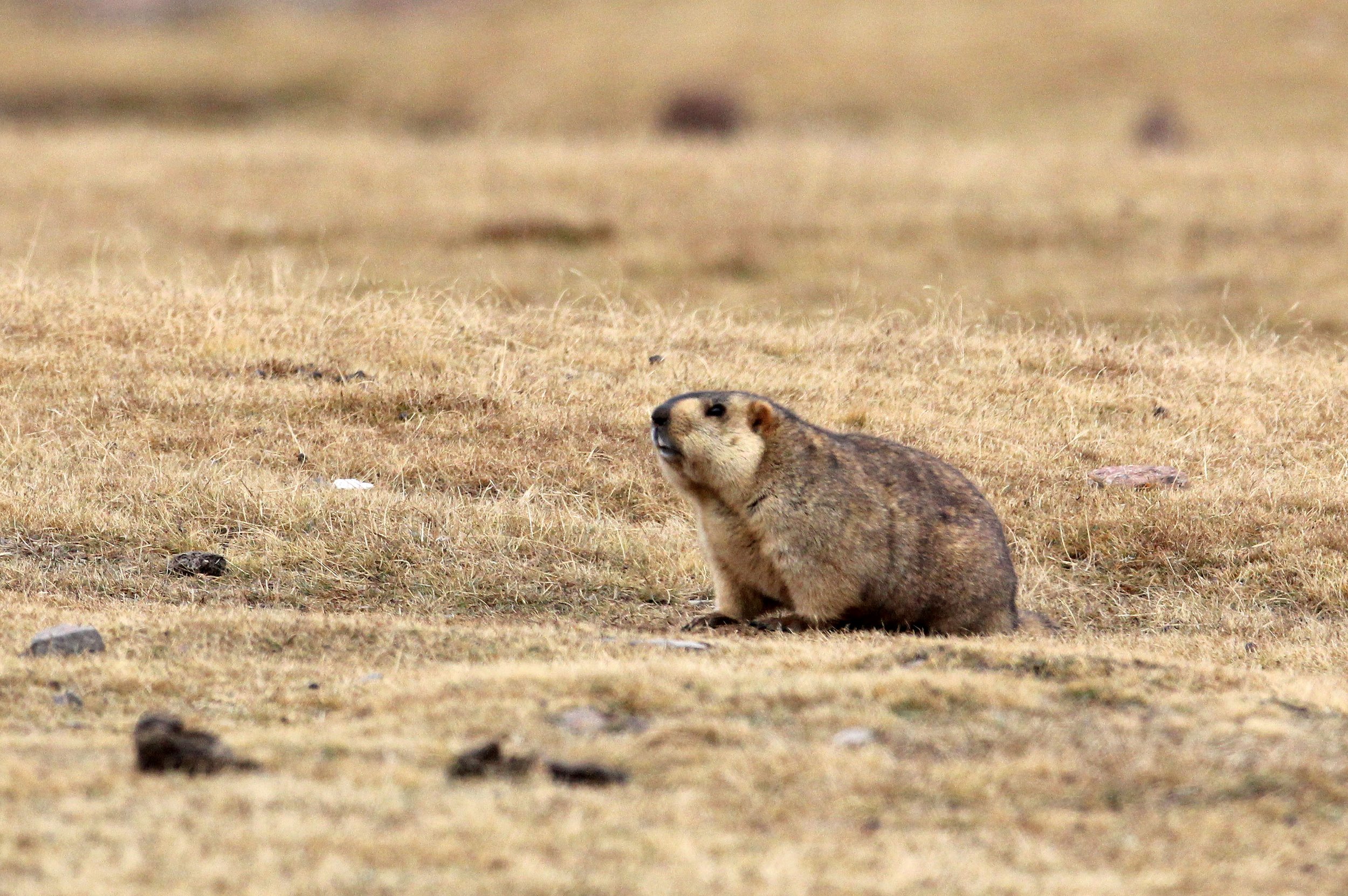
































The Alpine Marmot (Marmota marmota) is a large ground-dwelling squirrel, from the genus of marmots. It is found in high numbers in mountainous areas of central and southern Europe, at heights between 800 and 3,200 m (2,600–10,500 ft) in the Alps, Carpathians, Tatras and Northern Apennines. In 1948 they were reintroduced with success in the Pyrenees, where the alpine marmot had disappeared at end of the Pleistocene epoch.
As its name suggests, the alpine marmot ranges throughout the European Alps, ranging through alpine areas of France, Italy, Switzerland, Germany, Slovenia, Slovakia and Austria. They have also been introduced elsewhere with sub-populations in the Pyrenees, France's Massif Central, Jura, Vosges, Black Forest, Apennine Mountains, and the Romanian Carpathians. The Tatra marmot (Marmota marmota latirostris Kratochvíl, 1961) represents an endemic subspecies of Alpine marmot that originated during the Quaternary period. Tatra marmots inhabit Tatry Mountains and Nízke Tatry Mountains. Marmots are abundant in their core population; in the Romanian Carpathians, for example, the population is estimated at 1,500 individuals. Alpine marmots prefer alpine meadows and high-altitude pastures, where colonies live in deep burrow systems situated in alluvial soil or rocky areas.
Marmots may be seen "sun bathing", but actually this is often on a flat rock and it is believed they are actually cooling and possibly this is a strategy to deal with parasites. Marmots are temperature sensitive and an increase in temperature can cause habitat loss for the species as a whole.
Alpine Marmot (Marmota marmota) - Alps regions of Europe, Stelvio National Park Italy, Vercours Region of Southeastern France

